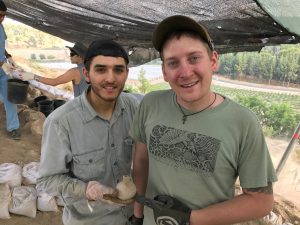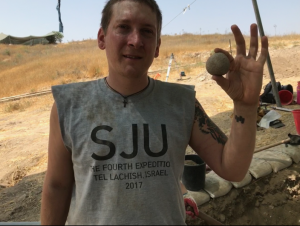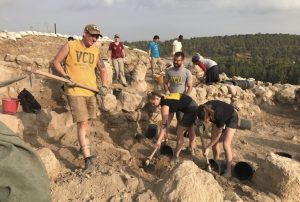
UNMAKING A HOME
Vincent Cason, 2017 Platt Excavation Fellowship Recipient
This past summer I was given the opportunity to be a square supervisor on The Fourth Expedition to Tel Lachish, directed by Yosef Garfinkel of The Hebrew University of Jerusalem and Michael Hasel and Martin Klingbeil of Southern Adventist University. I was placed under the supervision of Hoo-Goo Kang of Seoul Jangsin University. While this was my third excavation season at Tel Lachish, previously serving two seasons as a volunteer as an Anthropology major at Virginia Commonwealth University (VCU), it was my first time as a member of the Hebrew University staff. The promotion from volunteer to professional staff required a deeper understand of methodology, a sound interpretation as to what exactly was being uncovered, its relationship to material and strata found in adjacent squares as well as the overall site, and how material finds can support the larger questions of the excavation as determined by the directors (urban planning, social behaviors ethnic identification, etc.). Yet, perhaps what was most surprising about doing field archaeology lies beyond the scientific approach and more in the realm of intuition. It was around midseason that I began to lean on an uncanny sense of where to dig next and when to keep my eyes open.
But how does one really know what to look for?
A common theme in introductory classes to anthropology and archaeology is the holistic nature of our field, taking ideas and influence from many other fields and disciplines. This observation tends to lie dormant in the more theoretical side of things unless students actually have a chance to apply it to or through methodology. When taking part of an archaeological excavation, one can see that this holistic nature applies to much more than theory but additional includes what each staff member brings to the excavation. I found that a basic understanding of trade work can be an invaluable asset to understanding many parts of ancient society.
During my high school education, I focused on agriculture, as I was interested in the history of land use especially farming techniques and this was a strong program in rural North Carolina. I was a member of the Future Farmers of America, took classes on horticulture, and after graduation worked in landscaping for a period. While technology has changed quite a bit over the past few thousand years, many principles are constant, especially when it comes to agriculture. Grain production, from harvest to storage, to milling or grinding, then table use follow essentially the same trajectory even with modern invention. For example, terracing, an ancient method of farming, are still used today to allow agriculture in areas with steep topography.
During the 2017 season, much of my area was uncovering architecture which was another area I had practical work and classroom experience in. In my high school construction class, students built a house, auctioned off at the end of the semester, which in turn funds the class. And here I was, excavating houses! After removing nearly a meter of overburden in two squares, we had two immediate objectives which we methodically dispatched: find the floor and the foundation of the wall of the building. The same process of foundations, framing, flooring, and roofing I learned in high school guided me as I excavated the square, uncovering the walls, ceiling collapse, flooring, and foundational trenches in reverse order.
While I was able to lean on past academic and practical experience I did notice an important distinction between construction and deconstruction. Archaeology is often described as a destructive science because, once excavated, the archaeological matrix is gone forever, which necessitates meticulously recording while excavating. While excavating these buildings, I realized that destructive is misleading, that what we do is more “deconstructive” as we examine the structure, piece by piece, from the top down as it is “dismantled.”
This summer working on the Hebrew University staff at Tel Lachish was a truly insightful experience. I have deepened my understanding of what an incredible amount of social organization and labor goes into the building of a city, building a nation. It has left me feeling assured that I have chosen a career path that I truly enjoy, one that has real impact on the world around me. As a prospective graduate student there are few feeling that alleviate the anxiety of taking the next step in my education the way that feeling does. To those that are kind enough to fund fellowships such as the one I was awarded, I cannot thank you enough as I would not have had a chance like this otherwise and there are many others that are in the same situation.
Vincent Cason is a recent graduate of the Anthropology program at Virginia Commonwealth University in Richmond, VA. His research interests include state formation in the Iron Age Levant and agricultural practices in the general Near East. He is currently living in Richmond, VA and preparing graduate program applications.


